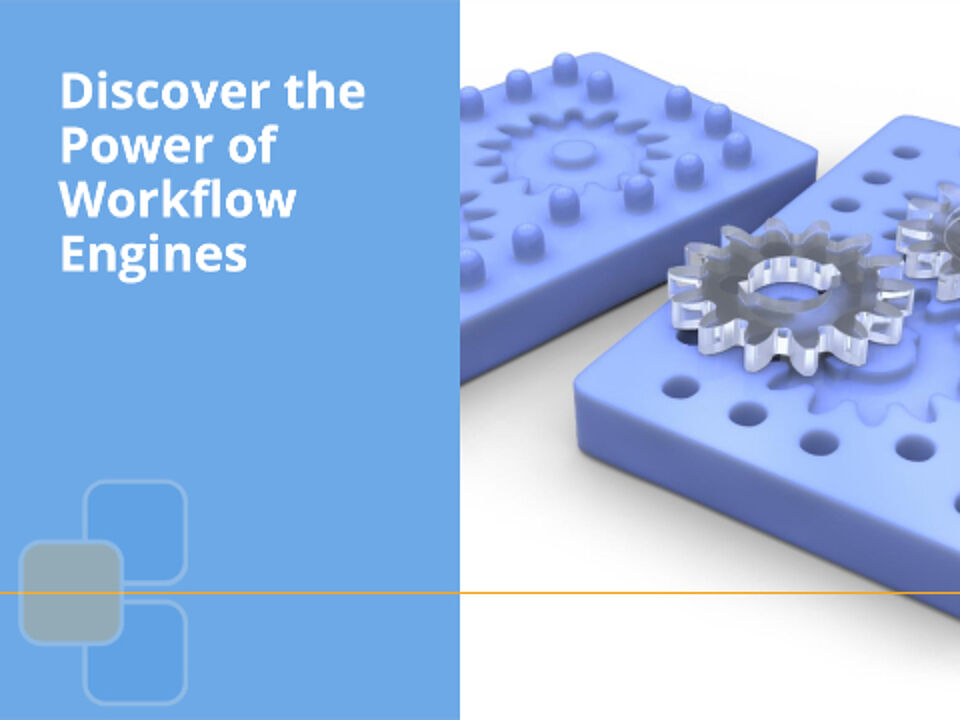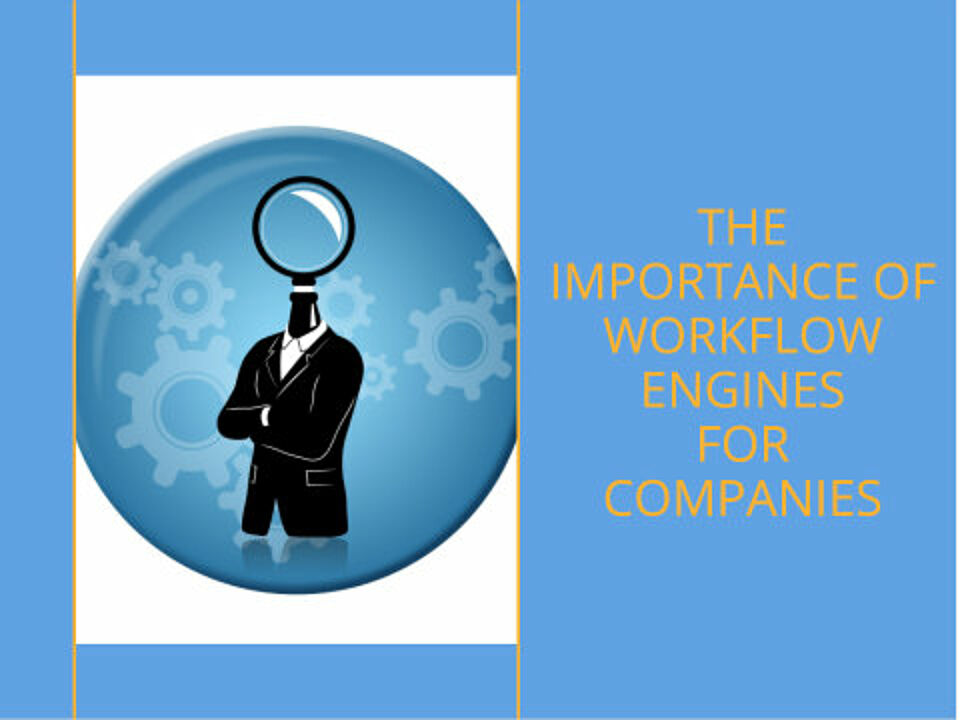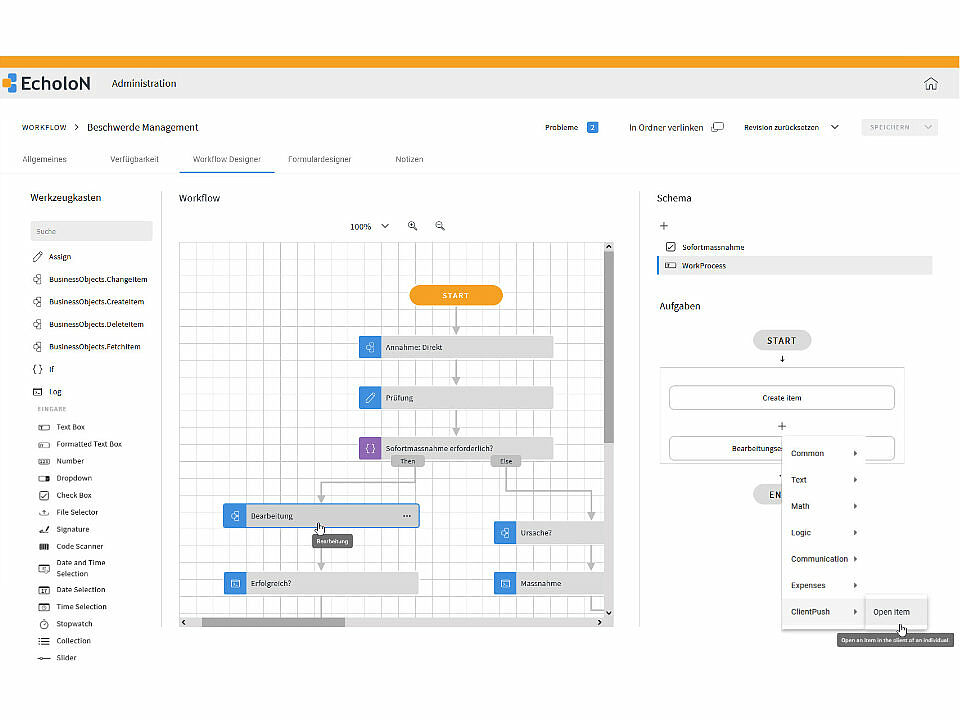
Workflow Management System - WFMS - The optimal solution for the execution and automation of business processes.
More and more, progressively complex work processes, steadily growing amounts of data, constantly recurring work steps etc. - almost every company has to struggle with this. Systems or software solutions that automate parts of the work processes and independently control the correct, error-free execution of these provide a remedy: so-called workflow engines, which act almost independently within a workflow management system (WFMS). What is it exactly? How does it work? You can read that in the following report - have fun!
Definition: what is a workflow engine?
In order to be able to explain what a workflow engine is, the term workflow-management-system (WFMS) must first be briefly clarified, because the workflow engine is an essential part of it.
Within the workflow management, business processes are supported by IT and in some cases completely automated (business process management). A workflow is a work process or a business transaction that is part of a chain of several workflows. These are interrelated in such a way that a condition must be triggered within the one workflow that is currently being processed in order to trigger an action in the next workflow.
The workflow management system thus includes all tasks that have to be processed in the organization, execution and control of the workflows.
This is where the workflow engine is used. It describes a software application that manages and monitors all business processes occurring in workflow management. The most important factors here are the statuses of the individual workflows, which the workflow engine uses to determine whether and which actions are triggered in the next step. Such actions can be, for example:
- Processing and / or approving a loan application
- Sending a reminder email
- Saving forms
- Passing on overdue actions to management
- Etc.
It all happens completely automatically. But how exactly does it work?

How does a workflow engine work?
Workflow engines have three primary functions:
- They continuously check whether the current process status is correct and valid.
- You control whether the user who is currently executing is authorized to execute the task.
- You carry out the task, provided points 1 and 2 are fulfilled. If the workflow engine carries out the task as intended, it transmits the new status of the task. If the task is not fulfilled according to the information, it returns an error message.
Work steps
The workflow engine supports the execution of processes by coordinating and automating the various work steps - Automation Workflow. Work steps can include creating tasks, assigning responsibilities, routing tasks to specific people or departments, and monitoring and collecting data.
Execution of processes
Processes are usually executed in the form of workflow instances. A workflow engine creates an executing instance for each workflow and orchestrates the execution of the different tasks and activities in the right order.
Workflow Engine Integration
A workflow engine can be integrated into existing systems and applications to improve the flow of information and seamlessly exchange data between different systems. For example, it can be integrated with ERP systems, CRM applications or other workflow management software.
The bottom line is that the software application can perform any kind of task within a business process. You look at the business processes in detail and define small work steps within them, which in turn can be technically automated and implemented in the workflow engine. This then assigns the respective work steps to users in the order that you specify. It functions as a controlling and executing entity within a workflow management system.
All of this leads to enormous relief and time savings for companies. What other reasons speak for a WFMS? And do companies really also need workflow engines?
Why is a workflow engine important?
Automation of business processes
Business process automation is a key benefit of a workflow engine. It enables businesses to eliminate manual tasks and increase efficiency by executing processes automatically.
Notifications and escalations
A workflow engine not only allows processes to be executed automatically, but also allows notifications and escalations to be sent. These features ensure that everyone involved in a workflow is aware of progress and can respond in a timely manner. Notifications allow staff to stay up to date on important events, while escalations ensure that tasks that are not completed on time receive the attention and prioritisation they need.
Reporting and monitoring
In addition to managing and optimising various workflows, it also offers features such as reporting and monitoring. Reporting allows companies to generate detailed reports on the workflow process. This allows them to gain insights into the efficiency of the processes and identify potential bottlenecks or areas for improvement. The monitoring function helps track the progress of workflows and ensure that no tasks are overlooked or delayed.
BPMN and Workflow Engine
The Business Process Model and Notation (BPMN) is a standard for modelling workflows. A BPMN workflow engine enables companies to model and control their processes according to the BPMN standard. It can perform various functions, such as the creation of process diagrams, the execution of process simulations, the automated execution of processes and integration with other company applications.

Why do companies need workflow engines?
Companies that opt for a workflow management system on the one hand and workflow engines on the other enjoy a number of advantages, for example:
- Cost efficiency: The software-based control of work steps enables teams and departments to work together much more effectively, as they can concentrate on the essentials. In addition, thanks to the partial automation, errors are detected and corrected more quickly. All in all, this saves a lot of time and money.
- Continuous improvement of processes: The fact that a work process is orchestrated by a workflow engine makes it much easier to implement changes or improvements. The individual task can be modeled and restarted without the entire process coming to a standstill. This ensures short processing times and at the same time no task can be forgotten because the workflow engine takes care of compliance.
- Employee satisfaction: Employees can concentrate on their tasks, are more productive and more effective. You can also find all information in a software application - without a long search. This makes them more satisfied themselves, as their work achieves visible results within a short period of time.
In order to actually benefit from all the advantages of a workflow engine, it is important that the software remains editable and optimizable throughout, in order to be able to take along the development of the market or innovations. Too rigid guidelines are unsuitable, as it is not possible to react spontaneously.
The automation of business processes must not lead to employees feeling restricted or even replaced in their creativity. Contrary to the positive effect of more effective work processes, this would have a negative impact on employee satisfaction and their performance.
When making a decision, companies should pay close attention to the options provided by the respective workflow engine providers and how high the degree of flexibility is despite automation. So where to look? How do companies find the right workflow engine for them?
Interaction between workflow engine (WFE) and robotic process automation (RPA)?
The interaction between WFE and robotic process automation is crucial for the efficiency and performance of automated processes in a company. WFE provides the necessary infrastructure and logic to manage and control complex processes, while RPA takes over the physical activities and automates repetitive tasks. By integrating both technologies, companies can ensure smooth and reliable processes that increase productivity and minimise errors. WFE can orchestrate workflows and control the process flow, while RPA takes over the execution of individual tasks, resulting in seamless collaboration.
Advantages of using a workflow management system
A workflow management system offers many advantages for companies. It enables efficient organisation and automation of workflows, resulting in fewer errors and higher productivity. By storing and managing information centrally, collaboration is facilitated and access to relevant data is improved. In addition, work processes can be made more transparent and bottlenecks can be identified. Overall, a workflow management system increases the efficiency and effectiveness of processes and thus increases employee and customer satisfaction.
Increased efficiency
Workflow management systems significantly increase the efficiency of companies. The automated handling of business processes and the transparent presentation of workflows enable effective monitoring and control. This results in time and resource savings. Employees can concentrate on their core competencies as repetitive and time-consuming tasks are automated.
Streamlined processes
Workflow management systems are an effective way to implement streamlined processes in organisations. Through a centralised platform, workflows can be automated and optimised, resulting in more efficient performance. The systems allow employees to work collaboratively on projects, delegate tasks and track progress. This can avoid unnecessary delays and misunderstandings.
Improved collaboration
Workflow management systems (WMS) enable improved collaboration in organisations. By automating workflows, tasks can be assigned and processed more efficiently, optimising collaboration between employees. Employees can access the current status of the project in real time and thus better coordinate their work. In addition, WMSs enable transparent and traceable communication, as all relevant information is stored centrally and accessible to all participants. The improved collaboration thus also contributes to an increase in productivity and effectiveness in companies.
Frequently asked questions - FAQs
What is a workflow management system?
A workflow management system is "automation software" that is used to automate and optimise business processes. This also applies to sub-processes, a work step or company-wide use.
What are the advantages of using a workflow management system like EcholoN?
By using a workflow management system such as EcholoN, companies can model, optimise and automate their process steps, saving time and resources and increasing efficiency.
How can the EcholoN workflow management system support process automation?
EcholoN offers a variety of tools and features to automate processes, including the ability to create BPMN diagrams, integrate document management and model and automate process steps.
Can the EcholoN workflow management system work with other software tools such as Camunda?
Yes, EcholoN is able to integrate with various tools and platforms, including Camunda, to ensure efficient process automation.
What kind of business processes can be automated with a workflow management system?
A workflow management system like EcholoN can automate a variety of business processes in organisations, including supply chain, accounting, human resources, customer service and more.
How can an organisation benefit from using workflow management software?
Companies can benefit from using workflow management software by optimising their processes, increasing productivity, reducing errors and improving overall efficiency.
Can the EcholoN workflow management system be integrated into a company's existing ERP system?
Yes, EcholoN can be seamlessly integrated into an organisation's existing ERP system to enable efficient orchestration of business processes.
What role do APIs and interfaces play in a workflow management system?
APIs and interfaces enable the integration of different systems and platforms to ensure smooth communication and data transfer between different tools and applications.
Does the EcholoN workflow management system provide support for modelling and automation of sub-processes?
Yes, EcholoN enables the modelling and automation of sub-processes to enable granular control and execution of business processes.
How can the use of a workflow management system such as EcholoN help to achieve the automation of business-relevant processes with minimum effort?
By using EcholoN, organisations can automate business-relevant processes with minimal effort by using a user-friendly platform and pre-built automation tools.

How do companies find the right workflow engine?
How do companies find the right workflow engine?
Companies that decide for a workflow engine face a large number of different providers and systems. It is not easy to keep track of things here. It is important to know exactly what is actually needed or searched for.
The following questions can help:
- How much budget can we spend on implementation and continuous improvement?
- Does the shortlisted system fit into my corporate strategy?
- Which possibilities or risks have to be considered in my company?
- Which software solution providers can help me with questions beyond implementation?
- Is it possible to couple my own systems with the new solution?
If answers have been found to all of these questions, nothing stands in the way of purchase and implementation.
We at EcholoN also offer such a WFMS including the workflow engines. Thanks to the graphic design, it is particularly user-friendly and can also be used immediately. One of the most important factors when using a new software solution, however, is to have a contact person for all questions and suggestions. This is exactly what our EcholoN employees do, because their opinion is that service begins with the purchase, not ends there. You can find more information about our extensive workflow management solution.
We look forward to your contact without obligations!
